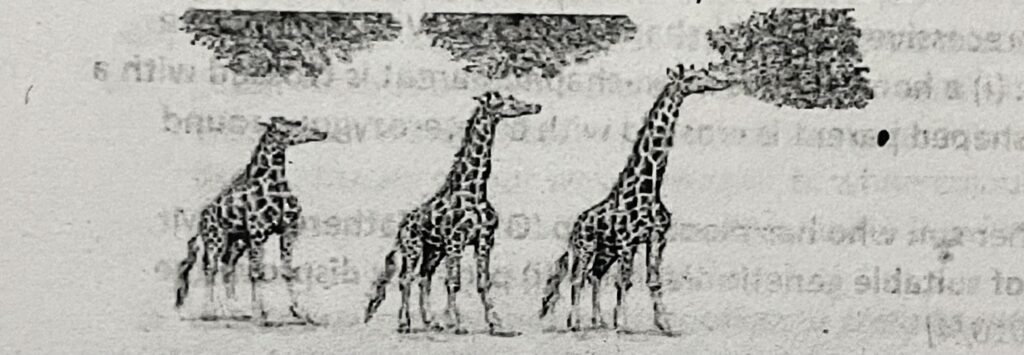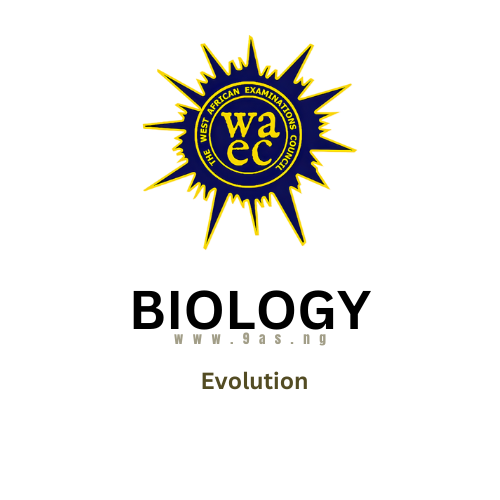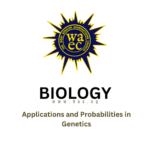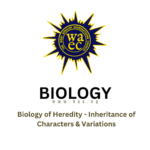OBJECTIVES
1. Lamarck’s theory of evolution is based on the fact that
A. organisms acquire genes from their parents.
B. organisms pass on acquired characters to their offspring.
C. characteristics of organisms are determined by the creator.
D. characteristics of organisms are the sum of their parents’ characters.
2. A scientist who was involved in the development of evolution theory is
A. Lamarck.
B. Mendel.
C. Morgan.
D. Pasteur.
The diagram below is an illustration of one of the theories of evolution. Study it and answer questions 3 & 4

3. Who proposed the theory in the illustration?
A. Louis Pasteur.
B. Gregory Mendel.
C. Robert Hooke.
D. Jean Lamarck.
4. The theory supports
A. struggle for survival.
B. natural selection.
C. independent assortment.
D. the use and disuse of body parts.
5. Which of the following occurrences cannot be taken as a direct observation of Natural Selection in recent times?
A. Industrial melanismin moths.
B. Selective breeding in cattle,
C. Insecticide resistance of some mosquitoes.
D. Development of long necks in giraffes.
6. The accepted concepts for the theory of Natural Selection does not include
A. tendency for organisms to overproduce.
B. struggle for existence.
C. survival of the fittest.
D. use and disuse of body parts.
7. Darwin noticed that organisms in similar habitats across the world looked alike. This illustrates
A. Convergent evolution.
B. Adaptive radiation.
C. Co-evolution.
D. descent with modification.
8. A dairy farmer allowed only his best milk producing cows to mate. In succeeding generations of cow milk production increased This outcome is an example of
A. artificial selection.
B. natural selection.
C. competition.
D. cross fertilization.
9. Which of the following statements reflects the mechanism of natural selection?
A. There are variations within every species.
B. Individuals of every species are genetically identical.
C. No organism in a species dies before sexual maturity.
D. Organisms with selective advantages are less likely to survive.
10. The theory of survival of the fittest was propounded by
A. Darwin.
B. Lamarck.
C. Linnaeus.
D. Mendel.
11. Natural selection is a consequence of
A. distribution of organisms.
B. adverse conditions.
C. variation in organisms.
D. inbreeding.
12. Which of the following components of Lamarck’s theory of evolution is considered faulty? A. Individuals of the same species growing under different environmental conditions differ from each other. B. Use of certain organs result in development of those parts.
C. Unused organs degenerate.
D. Changes that result in individuals of the same species are transmitted to offspring.
13. Which of the following terms is associated with natural selection?
A. Adaptive radiation.
B. Differential reproduction.
C. Population variability.
D. Survival of the fittest.
14. The gradual cumulative, adaptive and heritable changes in an organism over a long period of time
resulting in new species is called
A. adaptation.
B. survival.
C. organic evolution.
D. interspecific competition.
15. Evidence for evolution include the following except
A. fossil records.
B. comparative anatomy.
C. mutation of genes.
D. geographical distribution of organisms.
16. A blend of inherited and acquired characteristics shows
A. variation.
B. inheritance.
C. evolution.
D. heredity.
17. In evolution, analogous structures are significant because they show
A. physiological diversity.
B. functional diversity.
C. genetic diversity.
D. structural diversity.
18. In evolution, fossils are naturally preserved in
A. rocks.
B. water.
C. chemicals.
D. trees.
19. Which of the following sequences is the correct evolutionary trend in plants?
A. Algae liverworts→mosses ferns.
B. Liverworts mosses → ferns →algae.
C. Mosses algae ferns liverworts.
D. Ferns→ liverworts → mosses algae.
20. The order of evolutionary trend in plants is
A. Bryophyta, Thallophyta, Pteridophyta and Spermatophyta.
B. Thallophyta, Bryophyta, Pteridophyta and Spermatophyta.
C. Spermatophyta, Pteridophyta,up Bryophyta and Thallophyta.
D. Bryophyta, Pteridophyta, Spermatophyta and Thallophyta. anatomy.
C. Comparative embryology.
D. Fossil record.
21. The allele responsible for sickle-cell anaemia first appeared in the tropical and subtropical regions Of Asia, the Middle East and Africa It entered the United States of America when individuals were forcibly brought over from Africa. In micro evolutionary terms this is an example of
A. mutation.
B. gene flow.
C. genetic drift.
D. natural selection.
22. Which of the following statements is not associated with the theory of natural selection?
A. There is a struggle for existence.
B. There is competition among the offsprings.
C. The weaker offsprings are on A eliminated.
D. Food and other needs are w(t) alim abundant.
The statements below are about evolution of species
Members of a species vary
II. Organisms produce many offspring
III. The mechanism of evolution is inheritance of acquired characters
IV. Changes in the phenotype is to brought about by the individual itself
23. Which of the statement(s) is/are related to the Darwin’s theory of evolution?
A. I only.
B. II only.
C. I, II and IV.
D. II and IV only.
24. Which of the following fields of study may not yield strong evidence of evolution?
A. Fossil.
B. Histology.
C. Ecology.
D. Genetics.
25. Who formulated the theory of natural selection in evolution
A. Louis Pasteur.
B. Robert Hooke.
C. Jean Lamarck.
D. Charles Darwin.
26. Which of the following can be considered as a direct evidence of evolution?
A. Classification.
B. Comparative
C. Lamarck’s theory of evolution.
D. Derives theory of evolution.
27. Lamarck’s evolution theory could be summarised by the statement that
A. only the fittest can survive in a challenging environment.
B. species that are unable to adapt become extinct.
C. new characteristics do not arise in organisms in time of need.
D. the changing environment imposes structural physiological and behavioural changes in organisms.
28. The concept of use and disuse of parts was postulated by
A. Darwin.
B. Lamarck.
C. Miller.
D. Wallace.
29. Which of the following is not an evidence of evolution
A. Fossil records.
B. Comparative anatomy. embryology.
C. Polymorphism.
D. Comparative
30. The failure of a species to adapt to any environment leads
A. domination.
B. competition.
C. stunted
D. exinction
31. The theory of use and disuse of organs was growth. D. extinction. propounded by
A. Gregor Mendel.
B. Charles Darwin.
C. Jean Lamarck.
D. Louis Pasteur
32. Which of the following is not an evidence of evolution?
A. Fossil.
B. Anatomy.
C. Embryology.
D. Behaviour.
33. Which of the following is not included in the theory of natural selection?
A. struggle for existence.
B. offspring show variation.
C. inheritance of adaptive
D. structures.
D. disappearance of functionless organs. +
34. The theory of evolution by natural selection was first put forward by
A. Aristotle.
B. Darwin.
C. Linnaeus.
D. Boyle.
35. The gradual, cumulative, adaptive and heritable changes in an organism over a long period of time resulting in emergence of new species is known as
A. adaption.
B. survival.
C. regeneration.
D. organic evolution.
36. The long necks and legs of the present day giraffes were some of the basis of
A. Drawins’ theory of evolution.
B. Mendel’s theory of inheritance.
C. Larmack’s theory of evolution
D. Derives theory of evolution
37. In natural selection, Darwin proposed that evolution occurred because of the following conditions except
A. food and other needs are abundant.
B. there is a fierce competition among the offsprings.
C. that the weaker offsprings are eliminated.
D. that nature selects those that will survive to reproduce their kind.
38. 38.The evidence for evolution can be obtained from the following except
A. fossil.
B. anatomy.
C. history.
D. taxonomy.
39. The similarity between the bone structure of the arm of a human and the fore-limb of a rabbit indicates
A. adaptive radiation.
B. continuous variation.
C. a common origin.
D. convergent evolution.
40. The theory that new organs or characteristics develop in organisms when there is a need for them was
postulated by
A. Charles Darwin.
B. Jean Lamarck.
C. Gregor Mendel.
D. Wallace.
41. Which of the following scientists was involved with organic evolution?
A. Mendel.
B. Lamarck.
C. Morgan.
D. Pasteur.
42. According to Charles Darwin’s Theory of Evolution, natural selection involves the survival of the
A. weakest.
B. most populous.
C. youngest.
D. fittest.
43. Species do not change in order to survive. The environment determine which organism survives to
reproduce. These statements
A. explain the theory of acquired characters.
B. support Jean Lamarck’s theory of use and disuse.
C. support the idea of survival of the fittest.
D. are refuted by fossil records.
44. Mutation leads to evolution in that it
A. gives rise to offspring which have the same characteristics as the parents.
B. Kills all organisms where it has occurred.
C. gives rise to new individuals which differ considerably from their parents.
D. always confers adaptability to the offspring.
45. The wing of a bat and that of a bird, the flippers of a whale and the fins of a fish are examples of
A. adaptive radiation.
B. vestigial structures.
C. continuous variation.
D. convergent evolution.
46. Who proposed the theory of evolution by natural selection?
A. Darwin
B. Lamarck
C. Aristotle
D. Linnaeus.
47. Natural selection arises as a result of
A. gene mutation.
B. change of habitat.
C. reduction in population.
D. climate change.
48. Which of the following statements is not Lamarck’s postulate on evolution?
A. Great changes in the environment result in corresponding changes in species
B. Frequently used organs become well developed while the ones not used become vestigial
C. Well developed acquired characters are inheritable
D. Survivors in a competitive community must have inherited useful
traits
49. Which of the following sequences is the correct evolutionary trend in organisms?
A. Algae Liverwort →Ferns Angiosperms
B. Liverwort →Angiosperms-Ferns Algae
C. Angiosperms→Algae →Ferns → Liverwort
D. Ferns →Liverwort →Angiosperms→ Algae
50. A vestigial structure in humans is
A. gall bladder.
B. villus.
C. earlobe.
D. tail bone.
THEORY
1. (a) Define the term “Organic Evolution”?
(b) Outline the contributions of
(i) Lamarck
(ii) Darwin to organic evolution.
(c) List three evidences of organic evolution.
2. (a) Explain briefly Darwin’s Theory of Natural Selection,
(b) List five evidences to support the occurrence of evolution.
3. (a) Name two scientists who have contributed to the study of evolution.
(b) List five evidences to support the occurrence of evolution.
4. (a) Name two examples of features in animals that support the theory of use and disuse of body parts as used by Lamarck.
(b) List three structures in mammals that are vestigial.



